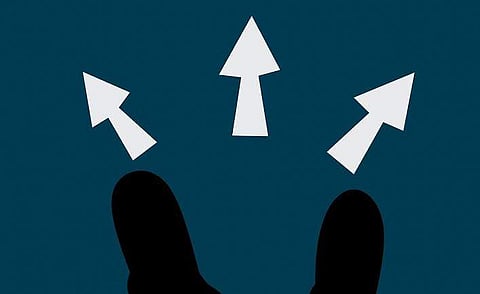

Rinku,’ said Rahul. ‘Be it deciding between idli or dosa or choosing between courses to study, I’m always confused.’
‘Yup,’ said Rinku. ‘You’re terrible at decisions.’
‘How do I improve this, bhaiyya?’ asked Rahul.
‘Practice,’ smiled Rakesh. ‘Understanding the decision-making process and practising it helps you make better decisions.’
‘What’s the process, bhaiyya?’ asked Rinku.
‘Our decision-making is hampered by four obstacles, according to Chip and Dan Heath who wrote the book Decisive,’ said Rakesh. ‘They are — having a narrow set of choices, confirmation bias, emotional hijack and overconfidence.’
‘How to overcome these four villains, bhaiyya?’ asked Rahul.
‘Widen your options first,’ said Rakesh. ‘Research proves that even having two options increases the quality of decision-making substantially. One way to widen options is to eliminate the ones you’re considering, which forces you to examine other options. Also, instead of looking at ‘this OR that’, examine ‘this AND that’ scenarios. Get more information from experts. Using techniques like these will widen your options.’
‘Interesting,’ said Rinku. ‘How to tackle confirmation bias?’
‘Confirmation bias is deciding beforehand that you like something based on past belief and then finding proof that confirms your decision,’ said Rakesh. ‘To avoid this bias, test your assumptions. Ask questions that disconfirm your bias.’
‘Test before deciding,’ said Rahul. ‘How do we guard against emotional hijack, bhaiyya?’
‘The best way to protect decision-making from an emotional hijack is to keep a distance,’ said Rakesh. ‘Others rush you into making emotional decisions — take your time. Detach yourself. Be an objective observer. Think like how you would if you were helping your best friend to decide. One technique to create distance is the 10/10/10 method — will your decision still hold as strongly after 10 minutes, 10 days and 10 years.
‘Any other techniques, bhaiyya?’ asked Rinku.
‘Looking at both worst and best case scenarios improves perspective,’ said Rakesh. ‘Make a list of your decision-making history — use insights behind good decisions to make more good decisions and create a stop-doing-list to avoid repeating bad decisions. Creating emotional tripwires that warn you when you’re uncertain helps. Practice right processes and your decision-making will surely get better.’
‘Thanks bhaiyya,’ said Rahul. ‘This will really help.’
